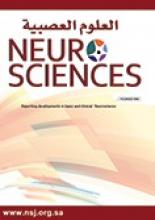Abstract
OBJECTIVE: To investigate the F wave parameters (F duration, F minimum latency, F maximum latency, F mean latency, F chronodispersion, and F persistence) of the tibial nerve with unilateral S1 radiculopathy. We evaluated the differences of these parameters between the affected and unaffected sides and also with the control group.
METHODS: The study was performed from September 2007 to January 2008 in the Electrophysiology Laboratory of Marmara University Medical Faculty, Istanbul, Turkey. Bilateral tibial F waves were obtained from 20 normal control subjects (control group) and 20 patients with unilateral S1 radiculopathy (patient group). Minimum, maximum, and mean F latency values were corrected by the subject’s height (F min/H, F max/H, F mean/H). Needle electromyography was performed in the patient group. The patients with a history of diabetes, alcoholism, or other abnormality known to affect peripheral nerves were excluded.
RESULTS: In the control group, no significant differences were found in any of the F-wave parameters between the 2 sides. In the patient group, there were significant prolongations of F duration, F min/H, F max/H, F mean/H, and F chronodispersion on the lesion side. Patients’ F durations of the affected and unaffected side were significantly longer than the control group. The F chronodispersion also showed significant prolongation on the affected side in the patient group compared with the control group. Among 20 patients, 15 had evidence of denervation or polyphasic potentials on needle electromyography.
CONCLUSION: The F wave study can be clinically useful in the evaluation of S1 radiculopathies, especially in patients with mild and early stage of the disease. Both F duration and F chronodispersion have a higher diagnostic value as compared to F min in the diagnosis of lumbosacral radiculopathy, especially in cases with normal findings on needle electromyography.
- Copyright: © Neurosciences
Neurosciences is an Open Access journal and articles published are distributed under the terms of the Creative Commons Attribution-NonCommercial License (CC BY-NC). Readers may copy, distribute, and display the work for non-commercial purposes with the proper citation of the original work.






